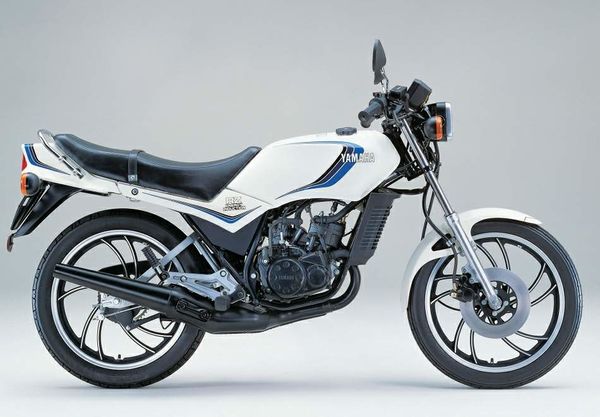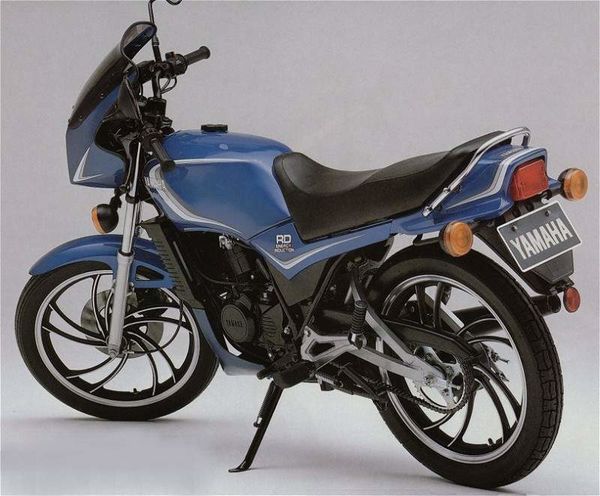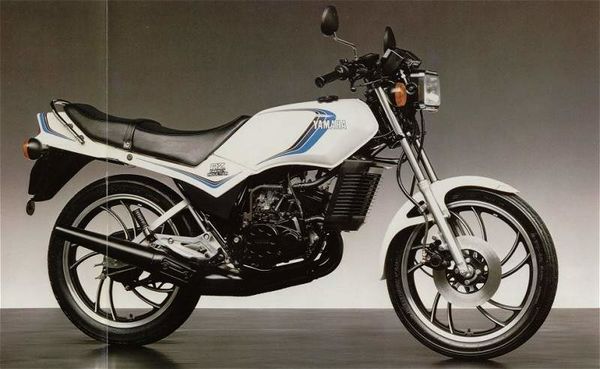Yamaha RZ125LC
| File:Yamaha-RD125LC 82 3.jpg | |
| Yamaha RZ125LC | |
| Manufacturer | |
|---|---|
| Production | 1981 - 82 |
| Engine | Two stroke, single cylinder |
| Compression ratio | 6.4:1 |
| Top Speed | 81 mph / 130.3 km/h |
| Ignition | Hitachi CDI |
| Transmission | 6 Speed |
| Suspension | Front: 32mm Telescopic forks Rear: Monocross linkage 6-way preload adjustment |
| Brakes | Front: Single 245mm disc Rear: 130mm Drum |
| Front Tire | 2.75-18-4PR |
| Rear Tire | 3.00-18-6PR |
| Wheelbase | 1295 mm / 50.9 in |
| Seat Height | 775 mm / 30.5 in |
| Weight | 98 kg / 216 lbs (dry), |
| Oil Capacity | 1.1 L |
| Recommended Oil | Yamalube 10w-40 |
| Fuel Capacity | 13 Liters / 3.4 US gal |
| Manuals | Service Manual |
It could reach a top speed of 81 mph / 130.3 km/h.
Engine[edit | edit source]
The engine was a Liquid cooled cooled Two stroke, single cylinder. The engine featured a 6.4:1 compression ratio.
Chassis[edit | edit source]
It came with a 2.75-18-4PR front tire and a 3.00-18-6PR rear tire. Stopping was achieved via Single 245mm disc in the front and a 130mm Drum in the rear. The front suspension was a 32mm Telescopic forks while the rear was equipped with a Monocross linkage 6-way preload adjustment. The RZ125LC was fitted with a 13 Liters / 3.4 US gal fuel tank. The bike weighed just 98 kg / 216 lbs. The wheelbase was 1295 mm / 50.9 in long.
Photos[edit | edit source]
Yamaha RZ125LC
Yamaha RZ125LC

 Yamaha RZ125LC
Yamaha RZ125LC

Overview[edit | edit source]
Yamaha RD / RZ 125LC
Road Test 1981
The Yamaha RD 125 twin this simple, effective long-running little-bike of the Yamaha family is also one of the most powerful lightweights around.
And, depending on how the laws are changed, it could also be a blueprint for future learner machines. A straight 125cc limit will have all manufacturers in a mini-performance race and the Yam will be the bike to beat. A ceiling on power would be a slightly different matter but who would measure the power, and how?
Either way, it isn't a good prospect for learners. Because, although the Yamaha
is a remarkably good bike, it isn't the easiest machine to get used to and, in
many conditions, a 250 is a lot easier to handle.
Already it is aimed at the (presumably) younger rider who wants a sporty image. And, on the whole, a summary of the RD is highly commendable; it is light, slim, maneuverable and its little engine runs cleanly over a 10,000 rpm rev range.
It will run to 70 mph and more but neither this nor its 14 bhp engine is the problem. The root of the trouble is that between 6,000 and 8,000 rpm the power output nearly doubles. This rather lively characteristic is combined with low weight, a short wheelbase and necessarily low gearing. It's not surprising that you can pull wheelies on the 125 much more easily than you can on the 100 bhp CBX. Whether you intend to or not.
The 125 also has no power worth measuring at low speeds it would be amazing if it did but from 4 bhp at 4,000, the output practically doubles with every 2.000 rpm. A first-time rider would probably have a hard time learning to pull away smoothly. It would certainly be a lot easier on a docile 250 which would have enough torque to get him rolling at a steady 2,000.
It is a bit unfair that this should sound like criticism of the Yamaha, but with the impending law, it is impossible to see it from any other angle. Once under way, the two-stroke is easily manageable and has the power to hold 60 mph into a stiff wind. Generally, it meant that main road cruising was pretty well flat-out and, up in its power band the motor would hold on to its speed.
Lower down, it wasn't so easy, and to cruise at 40 mph could often be hard work, with much gear shifting to cope with hills and sudden gusts of wind, even with the bow-waves of large trucks. Oddly enough, the 125 has only five gears and although the East Midlands is hardly mountainous, battling through Rutland against a stiff breeze, it seemed like seven gears wouldn't have been too many.
Low-speed running could be fairly economical, with nearly 80 mpg if the bike
were kept down to 45 mph. But the overall fuel consumption was poor, ranging
from a norm of 52 to 53 down to 43 mpg when the bike was ridden flat out. Like
most lightweights, the tank capacity seems chosen to match the size of the bike
rather than its thirst it rarely covered 100 miles before needing a refill.
The lack of a trip-meter on the speedo was an added disadvantage here.
Starting was always prompt, with the motor firing about half way through the first swing of the kick start, even on bitterly cold mornings.
Comfort was about average for a small bike. The seat is small and firm and not really big enough for two people. The low height makes it a bit cramped, which would be helped if the footrests were a lot further back. The suspension was also very firm, although this is probably preferable to the bouncy springing used on some lightweights.
It was difficult to gauge the bike's handling limits as the small tires and low weight give very little feel. But, combined with wide handlebars and light steering, these things can make the bike extremely maneuverable and nippy in traffic. Essentially, this is a good point, but once again it wouldn't benefit most learners. The last time we ran a group test on 125s we had a wide selection of riders although all of them had ridden before and we put the bikes through a slalom course to check low-speed handling.
The RD set the fastest time of all, but only two riders could go through the wiggles quicker on this than on one of the more sedate bikes. When the times for all the riders were averaged out, the RD came out worst. So it clearly has the potential, but it isn't too easy for the inexperienced rider to use to the full.
The light steering and very rapid pick-up from the motor could sometimes make
the bike react quite violently. There were times when this swift response was
very useful but there were other times when it could catch out an unprepared
rider.
The 12V lighting was good for the level of performance, as were the brakes, if you measure them by the standards of other 125s. But bigger and heavier bikes appear to have much better braking which, once again, leaves the little bike at a disadvantage. All of these characteristics are not unexpected in a 125, especially one in a fairly high state of tune. In fact the lively engine makes the bike fun to ride it also provides one of the cheapest machines for someone who wants to enjoy their motorcycling as well as having simple transport.
But the prospect of making learners start on such a machine throws a different light on the matter. Probably some people would take to the bike straight away, a few might have the patience to get thoroughly acquainted with it before doing battle in the city centre. But there will be others who will find it very difficult and the first few weeks of riding are risky enough without adding any further complications.
And that virtually sums up the little Yamaha. It has a better specification than most 125s and it can be shown to be one of the best machines on power, performance and handling. But the rider needs to develop the skill to find and use this performance. Most 250s would be a lot more manageable for the first-time rider.
| Make Model | Yamaha RD / RZ 125LC |
|---|---|
| Year | 1981 - 82 |
| Engine Type | Two stroke, single cylinder |
| Displacement | 123 cc / 7.5 cu-in |
| Bore X Stroke | 56 х 50 mm |
| Cooling System | Liquid cooled |
| Compression | 6.4:1 |
| Lubrication | Autolube |
| Oil Capacity | 1.1 L |
| Induction | 24mm Mikuni carburetors |
| Ignition | Hitachi CDI |
| Starting | Kick |
| Max Power | 20 hp / 15.5 kW @ 9500 rpm |
| Max Torque | 1.6 kgf-m / 16 Nm @ 9250 rpm |
| Transmission | 6 Speed |
| Final Drive | Chain |
| Front Suspension | 32mm Telescopic forks |
| Rear Suspension | Monocross linkage 6-way preload adjustment |
| Front Brakes | Single 245mm disc |
| Rear Brakes | 130mm Drum |
| Front Tire | 2.75-18-4PR |
| Rear Tire | 3.00-18-6PR |
| Dimensions | Length 1990 mm / 78.3 in Width 735 mm / 28.9 in Height 1190 mm / 46.8 in |
| Wheelbase | 1295 mm / 50.9 in |
| Seat Height | 775 mm / 30.5 in |
| Ground Clearance | 185 mm / 7.2 in |
| Dry Weight | 98 kg / 216 lbs |
| Fuel Capacity | 13 Liters / 3.4 US gal |
| Consumption Average | 64 mpg |
| Standing ¼ Mile | 16.7 sec |
| Top Speed | 81 mph / 130.3 km/h |